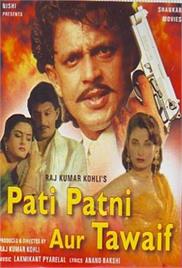Be Careful of Fake Websites. Always use HindiMovies.to domain & Join our Telegram Channel for Latest Updates.

Likes: 8
Views: 3.38K
Vijay Saxena is a well-known Bollywood actor-director in India. He lives with his wife, Shanti, and a child. When Bollywood actress Kiran throws a tantrum and walks out on his movie, Vijay is introduced to a prostitute by the name of Gauri. He likes Gauri and signs her up for his movie. Both Gauri and he get intimate, and as a result Gauri gets pregnant and gives birth to a daughter. Then Gauri meets with a young and wealthy movie financier by the name of Prince Kumar, and decides not to have to do anything with Vijay. She wants to bring up Vijay’s daughter as a prostitute like herself, so that she is provided for in her old age. Vijay must now decide to end his marriage with Shanti, or continue to live with her, knowing fully well that his second child will grow up to be another prostitute.
Released: 1990
IMDb Rating: 4.6/10 (25 Votes)
Genre: Drama, Family, Hindi Movies
Stars: Birbal, Harbans Darshan M Arora, Mithun Chakraborty, Salma Agha
Directors: Rajkumar Kohli
Writers: Lalit Mahajan, Charandas Shokh
Year: 1990
Server 1 – Dailymotion
Pati Patni Aur Tawaif (1990): A Deep Dive into the Drama and Intricacies of Relationships
Introduction
Pati Patni Aur Tawaif is a Hindi drama film released in 1990 that delves into complex human relationships and societal norms. The title, translating roughly to "Husband, Wife, and Courtesan," itself hints at a story woven around emotional entanglements and the various facets of love, loyalty, and social dynamics.
Plot Overview
The film explores the dynamics between a husband (pati), his wife (patni), and a courtesan (tawaif), where issues of trust, societal judgments, and personal desires come to the forefront. The narrative unfolds as these three characters navigate through challenging emotional and social landscapes, highlighting the often conflicted and nuanced perceptions of marriage, fidelity, and societal expectations in Indian society.
The story presents not just a love triangle but also comments on the role of women in traditional Indian settings, the stigma attached to courtesans despite their cultural significance, and the complexity of human emotions that defy simplistic moral categorization.
Director and Writer
The film was directed by Harbans Darshan M. Arora, a filmmaker known for his skill in portraying sensitive social themes with depth and authenticity. Harbans Darshan's direction ensures that the story is narrated with a sense of realism and emotional gravity.
Details about the screenwriter are not prominently listed in public databases, including IMDB, which suggests that the story might have been a collaborative effort under the director's guidance or by a writer not officially credited.
Principal Cast
Unfortunately, the IMDB listing for Pati Patni Aur Tawaif (1990) primarily highlights Salma Agha, but does not provide a comprehensive list of other cast members. Given the era and themes, it's likely that several veteran actors contributed to the storytelling, but their names are not documented prominently online.
Musical Aspects
Salma Agha is renowned not only as an actress but also as a playback singer, particularly for her mellifluous voice that added charm to many Bollywood songs during the 1980s and 1990s. It is natural to expect that the soundtrack of Pati Patni Aur Tawaif features soulful melodies that align with the emotional tone of the film.
The film falls within the drama and family genre which Bollywood movies in that era often complemented with songs expressing the internal conflicts of characters—whether regarding love, betrayal, or societal pressures. However, detailed information on the songs, composers, lyricists, or additional singers is not documented on mainstream databases such as IMDB or other popular music forums for this film.
Analysis and Impact
Pati Patni Aur Tawaif (1990), although not a widely cited classic in Bollywood cinema, addresses significant themes surrounding marriage and social stigmas, especially those related to courtesans—a subject often romanticized or dramatized in Hindi films but here approached with earnestness.
The movie serves as a mirror to the paradoxes inherent in traditional Indian society—where the institution of marriage is revered, yet fraught with complexities; where courtesans are simultaneously shunned yet culturally celebrated; and where the lines between morality and compassion blur in the theater of human emotions.
The narrative likely reinvigorates discussions on fidelity, emotional needs outside conventional relationships, and the humanizing portrayal of women conforming or contesting societal roles.
Conclusion
Pati Patni Aur Tawaif (1990) stands as a meaningful drama engaging with familial and societal relationships through a lens that balances sensitivity with stark reality. With Salma Agha's significant involvement, both in front of the camera and presumably the soundtrack, and under the direction of Harbans Darshan M. Arora, the film probably offers audiences a thought-provoking experience about love, betrayal, and societal confines.
For movie enthusiasts interested in Hindi drama films that explore complex emotional and social themes, Pati Patni Aur Tawaif offers a window into a poignant story from early 90s Bollywood cinema.
For further details, viewers can explore the original IMDB page: Pati Patni Aur Tawaif (1990) on IMDB.